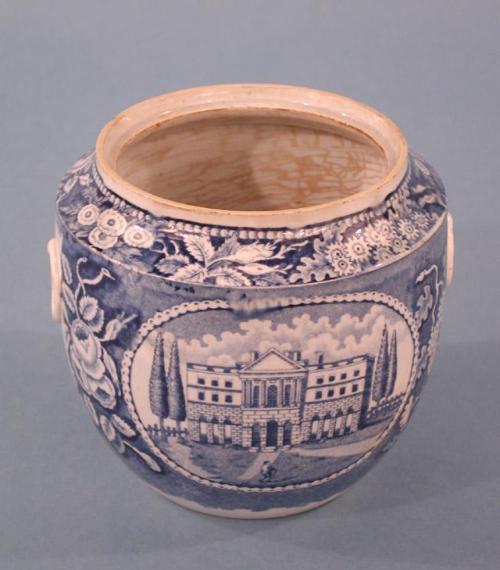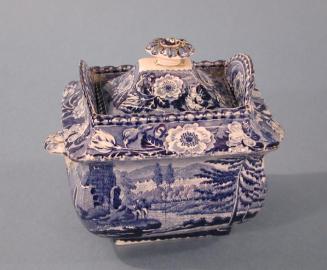Jar or Sugar Bowl
MakerAttributed to
Andrew Stevenson
(English, 1816 - 1830)
Date1816-1830
MediumMechanically-molded buff-colored earthenware with a blue-tinted glaze and underglaze cobalt blue decoration
DimensionsPrimary Dimensions (height x diameter): 4 5/8 x 3 7/8in. (11.7 x 9.8cm)
ClassificationsCeramics
Object number1967.40.0
DescriptionRound jar or sugar bowl of buff-colored earthenware with a blue-tinted glaze, a type of ceramic known as pearlware. The round jar/sugar bowl has a round foot, and sides that gradually swell before narrowing just below the rim. Two small rings of earthenware have been molded and applied to opposite sides of the jar/sugar bowl, giving the appearance of small handles. The jar/sugar bowl is decorated with a transfer-printed underglaze cobalt blue pattern titled, "State House Hartford" on the bottom. The pattern shows a neoclassical, or Federal style, building. The building sits on a tall, stone first floor, with two brick storeys above it. The structure has a projecting portico with six columns, a balustrade, and four chimneys emerging from the roof. There are two tall trees on either side of the building and a fence in the background. A man with a cane or walking stick is standing on the lawn in front of the building. The pattern is printed twice on opposite sides of the jar/sugar bowl, between the two applied rings or handles described above, and is surrounded by various flowers and leaves on a dark blue field. A border is printed at the rim, consisting of various flowers and leaves on a blue background. There is a final line of small, white, geometric shapes at the top edge of the rim.
The jar/sugar bowl probably had a lid at one point, however, it is now missing. The interior surfaces have crazing, which has resulted in spots and lines of yellow discoloration. One of the small rings on the outside has a slight yellow discoloration as well. A group of hairline cracks are visible on the bottom.
NotesSubject Note: The Connecticut State House was designed by Charles Bulfinch of Boston, and built by Jeremiah Halsey of Preston, Connecticut, and Andrew Ward of Guilford, Connecticut. The first session of the General Assembly was held in the State House on 11 May 1796. In 1878, the State House was turned over for use as a City Hall. In 1915, the Old State House was abandoned, and used intermittently for various non-governmental purposes. Several restoration projects took place over the following years, and in 1961, the Old State House was designated a National Historic Landmark. (Hunt 11/4/2004)The jar/sugar bowl probably had a lid at one point, however, it is now missing. The interior surfaces have crazing, which has resulted in spots and lines of yellow discoloration. One of the small rings on the outside has a slight yellow discoloration as well. A group of hairline cracks are visible on the bottom.
Status
Not on view












